
|
 |

|
 |
Shiva's Dance in Stone: Ananda Tandava, Bhujangalalita, Bhujangatrasa - ŠLiesbeth Bennink with Kandhan, Jayakumar and Sankar Deekshithar e-mails: liesbethpankaja@gmail.com, kandhan63@yahoo.com, naganathan.natarajan@gmail.com, shankarrnn@yahoo.co.uk August 12, 2012 (This article was originally published on June 29, 2012 in Asian Art, the on-line journal for the study and exhibition of the arts of Asia)  Nataraja or the Dancing Shiva is one of the best known and possibly most studied representations of the divine form within Hindu art. Shiva is pre-eminently the deity who expresses his divine being through dance. Although many different Tandavas or heroic dances are known from the tradition, the one called Ananda Tandava or Dance of Bliss is without doubt the one best known both for its artistic beauty and for its philosophical merit. The temple city of Chidambaram is especially associated with Shiva Nataraja who is the presiding deity of its great temple. Dancing with his right leg on the back of a dwarf, the left foot raised across in an elegant curve, and with four arms, the Nataraja represents the cosmic activities of Creation, Dissolution, Preservation, Concealment and Salvation. [1] 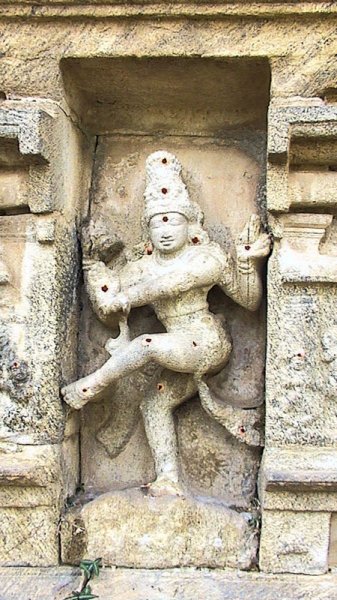 This dancing form of Shiva is most commonly depicted through the medium of cast bronze. Almost every temple in Southern India will have a bronze Nataraja which is carried in processions during temple festivals (fig. 1). Depictions of Nataraja are also found among the niche-deities on the walls of temples (fig. 2). And we find Nataraja as a subject of ornamental miniatures on pilasters and makara toranas (fig. 3). 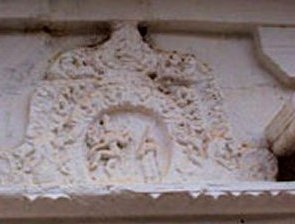 This article introduces representations of Nataraja in stone that have so far gone largely unnoticed. We will present 11 stone-carved Nataraja images found under worship in otherwise unrelated temples spread all across Tamil Nadu. These Natarajas are sculpted in the round and exist as independent murtis similar to the well known bronzes. Their existence raises questions on their relationship with the well known bronze Natarajas, to their place in the evolution of South Indian art, and their role in ritual. This article is a first attempt to offer an answer to these questions. For this we present a thorough analysis of their iconography and background. It is a mysterious group as it is completely impossible to assign any date or provenance to any of them. And we could not find much mythological or doctrinal material which would give these murtis a raison d'čtre. We have come to know of at least four more temples where stone Natarajas are under worship, in Sankarankoil, Tripuvanam, Thiruvapudayar and also Thiruthangal. Due to time restraint we were not able to visit these. These are therefore not part of our analysis. 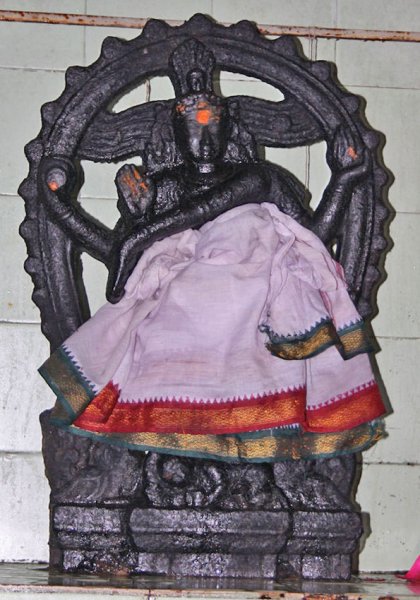 As all these Natarajas are part of the active worship in living temples it is not possible to make a definite description of all iconographic features. Application of oil or sandal paste for abhishekam, and the offering of veshti or dress make it impossible to fully study all the details of these Natarajas (fig. 5). We will concentrate on the hair and headdress, the prabha (circle of flames), and the Apasmara (dwarf trampled underfoot) for our analysis, plus whatever other relevant aspects we were able to distinguish.  Our first analysis establishes a few facts, and raises many more questions. As a group they show a lot of individual differences. The smallest is less than a meter in height, the tallest well over two meters. The treatment of Shiva's long tresses of hair, his jata (a kind of dreadlocks), is very different in each murti. Also the circle of flames, the prabha or prabhavali shows great variation, as does the way the sculpture of the dancing figure relates to the surrounding stone. The analysis of these individual stylistic features suggests a tentative chronology without leading to any definite conclusions. Size: The smallest Nataraja we found in the Vedapurishvara temple in Pondicherry (figs. 4, 4a). This murti is less than one meter in height. The tallest is without doubt the Nataraja in the Thousand Pillar Hall in the Minakshi temple in Madurai (fig. 6). The Nataraja in Avudaiyarkoil (fig. 7) is not of great height either. All the other Dancing Shivas are relatively large. Around 160 to 170 without the pedestal. Prabha or circle of flames:  Three Nataraja murtis, in Pondicherry, Avudaiyarkoil and Oothathoor (fig. 8), have an obviously oval prabha. Others in Thirunelveli (fig. 12), Thirupattur (fig. 9) and Thirupurankundram (fig. 14), a slightly oval prabha with makara (mythological aquatic creature) at the base. The prabha emerges from the mouth of these makara creating the suggestion of an oval shape. Three from Uttirakosamangai (fig. 14), Madurai (fig. 6) and Peraiyur (fig. 13) have a circular prabha. Again the makara at the base create an overall oval shape to the murti. Two even have a slightly flattened round shape (Thirupudaimarudur (fig. 12) and Thiruvedakam (fig. 11). All prabhas consist of a central broad body with two or more thin rims and an outer rim of flames Some prabhas have a very heavy body (Thiruvedakam (fig. 11), Thirupudaimarudur (fig. 12)), others have just a central body with two thin rims (Avudaiyarkoil (fig. 7), Oothathoor (fig. 8), Pondicherry (figs. 4, 4a)). In a few cases, the body and the rims have been decorated with abstract designs (Thirupattur (fig. 9), Madurai (fig. 6). The treatment of the flames is also individually very different. Sometimes the flames are shaped individually (Thiruvidaimarudur), sometimes exactly identical (Thiruvedakam (fig. 11)). Sometimes they are close together (Avudaiyarkoil (fig. 7)), sometimes somewhat apart (Peraiyur (fig. 13)). Sometimes the stone is left in the space between the flames (Pondicherry (fig. 4)), sometimes is has been removed leaving the flames standing alone (Thirupattur (fig. 9)). Makaras at the base: In all the murtis the prabha emerges from the jaws of two makara positioned on the base. Some are diminutive, as in Avudaiyarkoil (fig. 7) and Oothathoor (fig. 8). Some are extremely large and pronounced, for example in Madurai (fig. 6) and Thiruvedakam (fig. 11). In Peraiyur (fig. 13), Uttirakosamangai (fig. 14) and Thirupudaimarudur (fig. 12) the makara in their turn are positioned on pillars, some of which are bent. Summit decorations: Several of the icons also have a pair of makara placed at the top of the prabha. These are in Uttirakosamangai (fig. 14), Thirunelveli (fig. 5), Thiruparankundram (fig. 10), Thirupudaimarudur (fig. 12), Thiruvedakam (fig. 11) and Madurai (fig. 6). In some the flames evolve from smaller to larger at the top, with the topmost flame being larger than the others, as in Thirupattur (fig. 9) and Pondicherry (fig. 4). The Nataraja in Oothathoor (fig. 8) has a unique summit design. What may be naga or cobra heads spread from the crest of the hairdress in a fan shape across the body of the prabha. Shiva's hair: 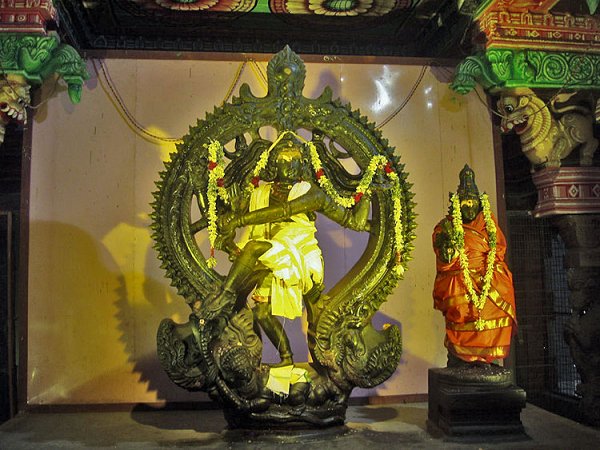 The jata or locks are a distinguishing feature in all forms of Nataraja. Whether they spread sideways or fall down the Divine Dancers's back points to a different doctrinal and mythological background to the murtis. Especially the Nataraja Ananda Tandava murti worshipped in Chidambaram wears his jata flowing down his back, because here Shiva dances the Shanti Kuttu, the Dance of Peace. It is the conclusion of the Cosmic Dance commenced in the Daruvana. He comes to a halt, and his hair drops down. Also the number of jata is considered in the texts. The Shilpa Shastras give clear directions on this as do the oral traditions. We find very different treatment of the jata and the hair in all these Natarajas. Some (Pondicherry (fig. 9), Peraiyur (fig. 13)) have the jata spread sideways. Others (Oothathoor (fig. 8) Uttirakosamangai (fig. 14), Madurai (fig. 6)) have the hair half falling down. The Nataraja in Thirupudaimarudur (fig. 12) has its jata falling completely down the side of the head. The other aspect of Nataraja's hair is the top-knot with the fan of crane feathers, the skull and the datura flower. Because of the worship with sandal paste, shawls and flowers it is not always possible to distinguish these features in the photographs. From our observation we can say the skull is present in all. The presence of the datura flower could not always be established. The hair and the fan of feathers have received very different treatment from the individual sculptors. Apasmara: The Apasmara, the dwarf trampled underfoot, lies facing to its proper right in all murtis. Some are very baby-like. Others (Thirupattur (fig. 9), Thiruvedakam (fig. 11)) have the features of a mature male and wear a moustache. All hold the cobra in their hand. In most this cobra rears its head up to the lifted foot of the Dancing Shiva, accidentally functioning as a strut to support this leg. The material: 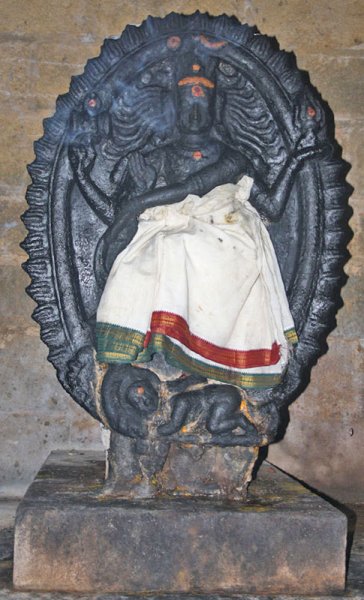 What is possibly most telling is the treatment of the material, the stone itself. In many respects stone is a more difficult material to shape compared to bronze. It is at risk of cracking and breaking. Especially for a figure as the Nataraja with the lifted leg jutting forward, the single standing leg being the sole support of the figure, and the gajahasta or bestowing arm held out and crossed in front of the image. With the stone Natarajas that are niche deities in temples the lifted leg or the crossing arm has sometimes broken off. This is definitely a challenge for any sculptor carving a free standing Nataraja murti in the round from stone. But only the Nataraja in Avudaiyarkoil (fig. 7) is done in solid stone. In Oothathur (fig. 8) two small openings have been carved around the top of the head. Also for the Shiva in Uttirakosamangai, the stone connecting the body with the prabha has largely been left in place. All others have been worked almost completely free from their stone background. The sculptors have dealt with this challenge through various creative solutions. Two (Periayur (fig. 13), Thiruvedakam (fig. 11)) have left the stone in place behind and around the standing leg, thus offering a lot of support. Many have been worked completely free from the background stone as in Thirupudaimarudur (fig. 12), Thirupattur (fig. 9), and especially Madurai (fig. 6). Here the largest stone Nataraja murti stands free of all supporting stone, except for a few cleverly designed struts in the shape of sashes and jata that are entirely functional to the figure. In others we see the gajahasta being supported by cobras (Peraiyur (fig. 13), Thiruvedakam (fig. 11)) in a way similar to the large cobras supporting the dancing foot. In Thirupudaimarudur (fig. 12) the struts are not so well disguised. From this analysis some general conclusions suggest themselves. Especially the observation of the relationship between the figure and the stone background offers a clue to propose a possible chronological evolution. As it is much more difficult to carve an image in the round with limbs that jut out without support, one can surmise the larger Natarajas that have had all the stone support around the standing leg and the torso removed are the result of a long evolution and a lot of experience with stone carving techniques. So we could conclude the largest Nataraja found in Madurai is probably the most recent.  By extension we see that the largest, free standing Natarajas have the largest makara, and these all have the summit decoration of another pair of makara, abstract medallions and a large top-flame in association with a heavy-bodied prabha. These are, besides the one in Madurai, the Natarajas in Thirupudaimarudur, Thiruparankundram, Thirunelveli and Thiruvedakam, without suggesting any particular order among them. The Emerald Nataraja in Uttirakosamangai belongs stylistically more or less to this group except that it is almost solid stone, and stone has also been left as support around the very lowest part, the bended pillars on which the makara are placed. This suggests an earlier phase and we may conclude this Nataraja could have been an inspiration to the others in this group. All these Natarajas belong geographically to the Pandya land. On the opposite end, we find the Nataraja from Avudaiyarkoil which has an oval prabha with small makara. The whole sculpture suggests a different, possibly much earlier, period. And so does the Nataraja from Oothathoor, although these are stylistically very different from one another. Both the Natarajas from Pondicherry and Peraiyur seem to be in between these two extremes. They are again very different from one another, both in size and stylistically. The Gowri Tandava murti from Tirupattur (fig. 9) with its ten arms and accompanying attributes reflects the description of Nritta murti, Dancing forms of Shiva, found in the Mayamata, a South Indian text on architecture and sculpture attributed to the 9th to 12th century. The text describes two dancing forms of Shiva called Bujangalalita (playing with the serpent) and Bhujangatrasa (dance of dread caused by the serpent). Dancing forms "Now the dance of Siva playing with the serpent is described, which is also called 'twilight dance.' (Siva) holds the damaru drum in his right hand and the fire is in the (corresponding) left one. In his (other) right hands he is to have the trident, axe, sword and arrow; in the left he holds the shield and the bow, makes the 'danda' gesture and carries the noose. His feet are made radiantly beautiful by the delicate movement of the steps of the dance. His right leg is bent and his left foot lifted to the height of his (right) knee; the space between the (left) heel and the (right) knee may be three times the value of the height of the face; the displacement of the right leg (in relation to the axis of the image) is nine eighths of the distance indicated above and the displacement of the left leg is to be determined according to circumstance. 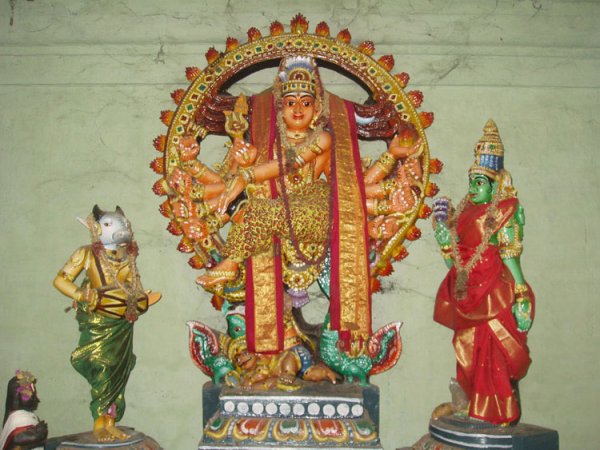 The face is upright but the body is slightly sway-hipped, according to one of the three modes. The thumb of the right hand which makes the absence of fear gesture (?) points towards the nipples; the (right) hand which holds the damaru is raised to the earlobe; the left arm, like an elephant's trunk, goes down to the level of the left foot and the sage is to arrange the left hand holding the fire in such a way that it comes up to the shoulders. It is the same for the distance between the armpit and arm (?). (Siva) carries a tiger skin (arranged) (?) in regular fashion; he makes the serpent gesture with one left hand and with the right one, or with the left, makes that of absence of fear (?). His flying, knotted locks are ornamented with cranes' feathers, his knotted coil of hair which is encircled by a garland of skulls, has the moon in it and his flying locks are five, seven or nine. On his left is Gauri whose height is a third (that of Siva) and, to his right, Nandikesvara; both are rejoiced by the dance and the music, and Bhrngin, who dances, is represented as above. Accompanied by gods, demons, Gandharva, Siddha and by Vidyadhara, Siva is surrounded by the Sages and honored by the multitudes of the gods. He is on a pedestal or a lotus. The dancing form called "dance of dread caused by the serpent", is to be installed in the same manner but (with the additional) Apasmara as the support of the (right) foot (of Siva). The worship of the dancing forms (of Siva) brings in return the immediate death of an enemy." [2] 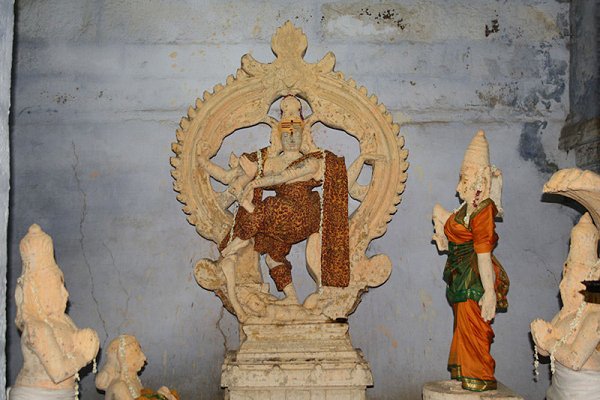 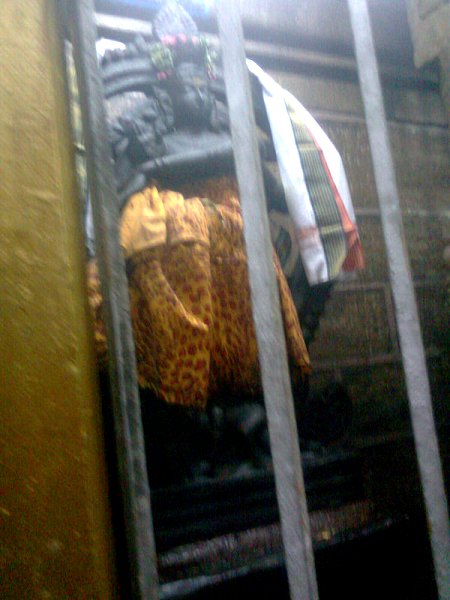 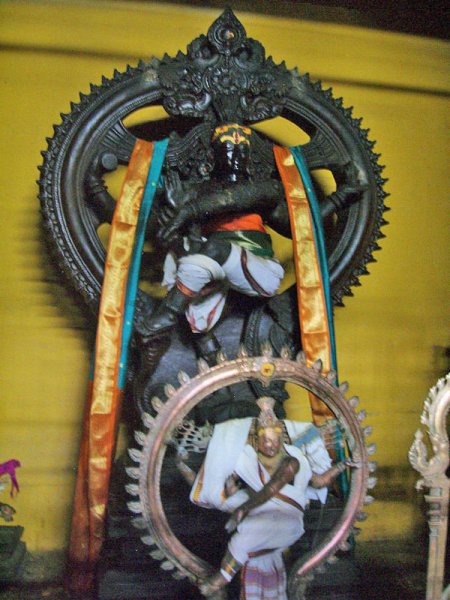 
The Nataraja in Thirupattur reflects the description of the Bhujangatrasa murti with its ten arms and attributes in the exact same order, and the Apasmara under his right foot. As far as we know this is the first time this form has been identified and is illustrated in plastic form as a worshipped Nataraja. At the same time we may wonder about the names of these murtis and what could be the puranic and ritual background of these dancing forms. The mythology of the temple tells that Mahalakshmi wished to see Shiva's cosmic dance and that Shiva performed the Gowri Tandava as it is known especially in this place for her. 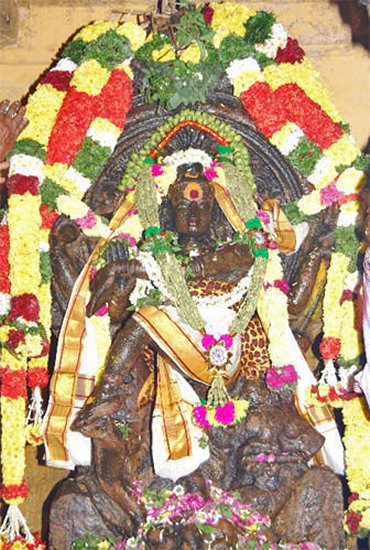 The Mayamata is thought to have been composed between the 9th and 10th century. Did the Nataraja in Tirupattur inspire the Mayamata or was this murti created on the basis of the text? Could this Nataraja murti belong to pre-Chola times? With its oval prabha, relatively small makara, absence of summit decoration, and small cobra in the hand of the Apasmara, it could be deduced this murti also may belong to an earlier period. The group of large and completely free-standing Natarajas, which includes those from Madurai, Thirupudaimarudur, Thiruvedakam, Thiruparankundram and Thirunelveli, would most likely belong to the Nayaka period. This conclusion is only based on circumstantial evidence. Their size, the technical challenge of their creation and maintenance and the mature features of the Apasmara all point to a later period. As does the fact the stone Nataraja in Madurai is situated in the Thousand Pillars Hall which was build in 1569 during the Nayaka rule. [3] The two Natarajas from Oothathoor and Avudaiyarkoil seem to be most archaic. And as the Nataraja from Tirupattur reflects the description of the Bhujangatrasa Tandava described in the Mayamata, a text thought to have been composed between the 9th and 12th century, this murti could belong to a period well before the Nayaka dynasty. Therefore the other archaic Natarajas could all be of much earlier dates altogether. 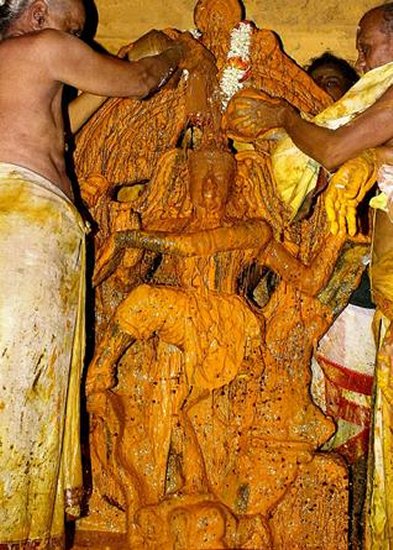 Without puranic, epigraphical or literary evidence, no definite conclusions about the origin and purpose of these Nataraja murtis can be drawn. Why would these sometimes unusually large stone Natarajas have been sculpted? This is especially relevant as in the same temples bronze Natarajas are also present. Were they intended to be carried in processions, like their metal counterparts? Did these stone Natarajas perhaps precede the murtis cast of bronze? It used to be thought the Nataraja Ananda Tandava murti was a creation which emerged in the10th century under the patronage of the Cholas. [4] The metallurgical analysis of bronzes by Dr. Sharada Srinivasan proved Nataraja was already under worship during the time of the Pallava dynasty. [5] The discovery by the late Raja Deekshithar of a relief of Nataraja in the Nageshvara temple in Kumbakonam which can be dated to the 9th century confirmed the worship and pre-eminence of Nataraja dates to earlier periods. [6] Dr. Srinivasan suggests in her article that the processional metal murtis were perhaps preceded by sculptures made of wood, plaster or stone. [7] Were any of the Natarajas described here once the utsava murtis for the festival? Only two of the eleven Nataraja murtis could have been easily carried. These are the Natarajas from Avudaiyarkoil and Pondicherry. That doesn't mean the purpose of processional murti cannot be ruled out though. Although some, especially the one in the Minakshi temple in Madurai, seem to be altogether too heavy and voluminous to allow for regular processions. At present, no such purpose is recalled in any of the temples. All Natarajas are positioned in a separate space facing south. Mostly this space is open in access and spacious and does not have the general lay-out of a sanctum or a sabha. Bronze Natarajas are usually found in a shrine shaped in the form of the Golden Sabha of the Chidambaram temple. All are accompanied by the consort Sivakamasundari (figs. 9, 12), and the majority also by the saints Patanjali (fig. 15) and Vyaghrapada who are especially connected to the mythology of the primary Home of the Dancing Shiva, the sacred city of Chidambaram.  Our knowledge of early (South) Indian history has many large blank spaces. Recently new archeological evidence and discoveries made by R.E.A.C.H., a dedicated organization of temple cleaners and renovators, introduces us to the possibility that temple worship and ritual may have had a long evolution before granite temples were introduced. [8] Also other remains of early brick built temples are being identified. [9] Dr. Sharada Srinivasan's research shows that the earliest known bronzes were depictions of iconographical fully developed images of gods and goddesses made under the Pallava dynasty at the same time stone built temples were introduced. As we now understand temples constructed of brick, wood and lime preceded temples built of granite, it is also possible murtis made of other materials preceded the processional deities cast of bronze. The discovery of the existence of a whole new class of Dancing Shiva Nataraja murti carved of stone raises the possibility these murtis are the evidence of this earlier period of evolution of Agamic temple ritual. DESCRIPTION OF THE ICONS Atmanathaswami temple in Avudaiyarkoil  The shrine of the Nataraja is found in the North-East corner of the main prakara and faces south in the general alignment of the temple. It is situated on the raised platform of the veranda of the corridor with a short flight of steps giving access. In this sanctum, we find the Nataraja on a plain square pedestal on which a roughly cut irregular stone forms the actual base of the murti. This stone seems to be decorated with what may be nagas (cobras) or abstract figures. The murti may be approximately 1.20 meter in height. Because of the worship with oil ablutions, not all details are clearly distinguishable and because of the dress, not all of the murti is visible. The prabha is oval and consists of a broad and round main body and two thin rims. What seem to be a sun and moon are carved at the top. The flames are clearly and individually carved and have five fingers each. The flames from the proper left hand down seem to have a slightly different shape, but this could be an illusion due to oil residue. The prabha appears from what are probably two makara mouths but these are not very clear. The whole background between the figure and the prabha is solid stone. There is no special medallion or illustration at the top of the prabha. The Apasmara lies with its head to the proper right of the figure with its face turned to the viewers. It has baby-like features and holds what is probably the tail of a large cobra that raises its head towards Nataraja's lifted foot under the cloth. The earrings are not clearly visible under the oil. The jata are somewhat falling sideways with ends upturned. There seem to be 7 jata on the left and 8 on the right side of the head. Some more tresses seem to be falling down the shoulders. A moon sickle is visible above the jata on then left. What is probably the figure of goddess Ganga is only partially clear due to the oil. Nataraja's head is crowned with a fan-shaped headdress in which a diminutive skull is positioned in the centre. The top of this fan-shaped headdress touches and slightly covers the prabha. The presence of a datura flower cannot be verified. The upper right hand holds the tail of a cobra which in turn is wrapped around the damaru or hourglass shaped drum. The flame of the upper left side rests on a small vessel. Under the lower left hand something is visible which can't be identified and which could be another cobra. Suttha Rathnagirishvara Temple, Oothathoor [10]  The sanctum of this stone Nataraja is situated in the North-East corner of the prakara, faces south and is open and spacious. Only the Nataraja and the Sivakamasundari are present. Only two steps lead into this space where the pedestal of the Nataraja and his consort are placed on what can be called a very low platform. With the pedestal, this murti is possibly some 2 meter high. Without the pedestal, this Nataraja is approximately 1.60 meter tall. The lowest part of the pedestal is square with a part left standing in the right corner. Above this the pedestal is round or oval in shape and consists of levels of molding. Its prabha is oval with two rather slender unpronounced makaras placed at its base. Its main body is broad and round and is encompassed by two slender rims. The flames are almost abstract and look almost like small waves. They are positioned close together. Where the headdress touches and covers the prabha, some kind of wave-shaped decoration is forming the top of the prabha. Around the makaras that form the base of the prabha are curling or waving decorations, possibly foliage. The Apasmara lies with its head to the proper right. It wears a diadem or a row of curls around its face and holds a relatively small cobra in its hand. There are only a few (fig. 3 or 4) jata or dread-locks which partly fall down, partly curl up around two hollowed out parts of the background of the murti. Otherwise this murti is solid stone. The goddess Ganga is positioned on the proper right side on the highest jata. The head is topped with a double fan of feathers or leaves with a skull in the center. Other hair attributes cannot be verified because of the flowers offered on the head. The female and male earrings are clearly defined. The upper-right hand holds the damaru. On the upper left, a small vessel forms the base for the flame. Between the dola-hasta and the raised leg is something which may be another cobra. Vedapurishvara temple, Pondicherry  The sanctum is situated in the North-East corner of the prakara and faces south. It is a simple tile covered space without any special features. Of all the stone Nataraja murtis we were able to include in our survey this one is the smallest. It is between two and three feet in height. Together with the pedestal, this murti is probably less than 1.20 meter high. Goddess Sivakamasundari is by his side. Patanjali and Vyagrapada are not present. The pedestal is rectangular with the central bay protruding and is build up of several slight moldings. Although the murti is largely covered by a cloth, it can be deduced two large makara form the base of the prabha. Their tails are just visible. The main body of the prabha is round and broad and is encased in two slim rims. The flames are depicted in an almost abstract fashion and are positioned slightly apart from each other. At the top, the prabha is covered with the head dress.  The Apasmara is only just visible under the cloth and lies with its head towards the right. It probably holds the tail of a cobra in one of its hands. The 6 jata on each side of the head form two solid bodies stretching sideways from the head. On the proper right a diminutive moon can be seen on the locks. Around the head and shoulders more curly hair or jata are falling down. The earrings are not clearly visible. Curls or a kind of diadem decorates the forehead. A fan of feathers in which a human head or skull is placed crowns the head. The figure of the Nataraja is fully free. All the background stone has been removed. The upper-right hand holds the damaru, the upper-left the fire. It is not obvious whether the flame is placed on a vessel or not. Edakanatheswarar temple, Thiruvedakam [11]  This Nataraja is placed in a walled off space with a wide entrance and harmonica doors in the North-East corner of the prakaram together with other bronze murtis and faces south. The murti is placed on a raised platform on a high and square pedestal. Pedestal and murti together may be two meter in height. The murti by itself is possibly 1.60 to 1.70 meters. The prabha is round with very broad, heavy and solid. Its central broad and round body is encased with several thin, decorated rims. Many almost abstract and identically shaped flames are placed close together. Two very pronounced, large beaked makaras form the base of the prabha. At the top, the prabha also appears from the open mouths of two makaras. Between the makaras is a large medallion which is crowned by further abstract decorations forming a shikhara. Shiva's headdress connects to de decorations at the top of the prabha. The Apasmara lies with its head towards the right. It is a dwarf-like grown man with a moustache and a large hair-do. It holds a large naga which raises its head to the raised foot of the Nataraja. The 5 jata form two solid bodies stretching sideways away from the head with a gentle wave with a small moon sickle on the left uppermost jata and a small Ganga on the right on the uppermost jata. They are decorated with small flowers placed in a very symmetrical manner. Jata or curls are also falling down the side of the head onto the shoulders. A diadem decorates the forehead. A double fan with a skull in the center crowns the head. Other head attributes cannot be established. Another naga is wrapped around the wrist of the crossed arm with its head touching the palm of the dola-hasta. The body of the Nataraja is worked free from the prabha, except between the makaras. It may be the standing leg is sculpted in the round and free from the supporting stone which gives solidity to the prabha. This would be a sculptural achievement. Damaru and fire are in the right and left hand respectively. Minakshi and Sundaresvara temple, Madurai  This Nataraja is situated at the top end of the Thousand Pillars Mandapa in the North-East Corner of the temple complex and faces south. The murti is placed on a festival platform carried on the back of a cosmic Kurma or tortoise with Dikpalas, Elephants and Nagas placed around the sides. The murti itself has a very low round base. This murti is probably the largest stone Nataraja we have seen. Possibly over 2 meters in height. The prabha is round with a broad solid body and thinner rims. All are decorated with abstract patterns. The flames are clearly defined and set closely together. The base of the prabha is formed by two makaras with large beaks and tails. The top is formed by another two makaras and several medallions on top of one another, ending in a crowning flame-like shape. Apasmara lies with its head towards the right. It is a mature male with bulging eyes and a large head-dress. The cobra's body is depicted under the body of Apasmara and raises its head to a great height, touching the foot of the Nataraja. On each side of the head, three jata spread sideways, falling down. Around the head and on the shoulders are further, shorter locks. The stone between the locks and the shoulders has been cut away. Ganga and Chandra are placed between the jata and the prabha. The head is topped with double fans of feathers with the skull placed in the center. He wears a diadem and the male-and-female earrings. The damaru is held by a naga wrapped around it. Nataraja holds the tail of the naga. The flame on the left burns on a small vessel held in the palm of the hand. The body is worked free from all the surrounding stone, including the part around the standing leg. Only a few struts and some sashes attach the body to the prabha, supporting it. Murugan temple, Thiruparankundram  This Nataraja is similar in nature to the others we found. It is also similar in being different in its details. It is largely covered with cloth which means we are not able to give a detailed description. It is kept in an open space protected with bars in the gallery in between several flights of stairs leading to the main sanctum. It faces towards the sanctum, which means it faces towards the South. The murti is around 1.60 meter tall and rests on a high rectangular pedestal. Together these are over 2 meters in height. The prabha is round with a broad body and rims. The flames are clearly depicted and placed close together. Large makaras are present at the base and the top of the prabha and it is crowned by a flame-like decoration. Jata are falling down on the shoulders. Narumbunathar temple, Thirupudaimarudur  The Nataraja is housed in a spacious and open sanctum in the North-East corner of the prakara and faces south. His consort Shivakamasundari and the saint Patanjali and Vyaghrapada are present in the same space. The murti is fully covered with sandal paste from the abhishekam, making distinguishing details difficult. Together with the rectangular pedestal, it may be over 2.10 meters in height. The Nataraja proper is probably at least 1.70m high. The pedestal is build up of traditional moldings such as an upana, upapitha, padmabandha and kapota. The prabha is round and heavy and is composed of a broad and round body with several layers of rims. Two makaras with large mouths and tails are clear elements above a kind of base. Two makaras occupy the top of the prabha, with a medallion in between. This is topped with a huge flame or shikhara. It is not possible to distinguish all the details of the makaras or this peak-decoration. The Apasmara lies with its head towards the right and wears a kind of diadem and flame or fan-shaped crown. It holds a large naga in its hand which raises its head up to Shiva's left foot. The jata fall down around the head and ears and on the shoulders. Shiva wears a kind of diadem and a kind of crown. Details cannot be distinguished. From the head two struts connect it to what seems to be streamers from the mouth of the makaras which form some kind of decoration under the prabha. The space around the body is completely worked open and the body is free from the stone background. Also around the legs, the background stone has been removed to leave open space. The sculptor has even carved away the stone between the earrings and the shoulders. A strut seems to have been left in place to support the lower hands. The upper right hand holds the damaru and the upper left a small vessel from which the flame blazes forth. Nellaiyappar temple, Thirunelveli  This Nataraja is situated in a spacious room behind the famous Copper Sabha in the North-East corner of the second prakara of the Nelveli temple. He is accompanied by Sivakamasundari, the saints Patanjali and Vyaghrapada, as well as several other minor murtis. Here too, the Nataraja is covered with sandal paste making distinguishing details difficult. With kumkum and soot, the features of the face have been illustrated over the sandal paste. The murti is easily over 2 meters high, including the pedestal. The Nataraja by itself could be well over 1.60m in height. The pedestal is rectangular with light moldings. It is placed on a low rectangular or square base. The prabha is round and has a very elaborate and heavy base. This base probably consists of makaras but because of the sandal paste this cannot be verified. The body of the prabha consists of several rims. There are no clearly distinguishable flames. At the top of the prabha there are also two makaras from whose mouth the prabha appears. In-between is a kind of medallion crowned by a large flame. The Apasmara lies with its head towards the right. A naga rises from the hands of the Apasmara to the dancing foot of the Nataraja. The jata spread out from the head in a downward wave. The decoration on the sandal paste indicates there are three jata on each side. These jata connect to the prabha. Between the jata and the shoulders, struts have been left for support. There may also be tresses falling onto the shoulders. Above the head a fan-shaped head-dress is apparent. Due to the sandal paste no details can be distinguished. The body of the Nataraja is largely free, except for some supports in the form of sashes and struts. Mangalanathar temple, Uttirakosamangai [12]  The Emerald Nataraja as it is known has a separate sanctum in the North-West corner of the outer prakara of this temple. Here Sivakamasundari, Patanjali and Vyaghrapada are under worship in a shallow space closed with a harmonica gate. Only on Arudra Darshanam (when the full moon transits the nakshatra Ardra in December-January) this gate is opened and abhishekam is performed for the Nataraja and his consort. The rest of the year, this Nataraja is kept covered with sandal paste. Many details are therefore not visible. This murti is totally around 1.70m in height. Without the pedestal, it is around 1.50 meters tall. The pedestal is a rectangular base which has been kept attached to the lower part of the sculpture. The prabha is circular and very broad with a solid body and many rims. The flames are close together and uniformly shaped. Two makaras are positioned on a kind of bended pillars. The prabha emits from their mouths. At the top of the prabha, another pair of makaras produce the prabha from their mouths and are topped by a large flame and abstract decorations. Around the head and the hair and connecting to the prabha, some unusual decorations have been added similar to the Nataraja in Thirupudaimarudur and Thirunelveli. The Apasmara lies with its head toward the (proper) right. The large cobra in its hand raises its head up to the left foot of the Nataraja. The five jata on each side fall down with a soft wave. The fan-shaped headdress connects to the prabha and partly covers it. Other details cannot be ascertained. This Nataraja is almost entirely solid. The sculptor has opened only a little of the space around the murti and has left a lot of stone as extra decoration between the prabha and the Shiva. Also the base is unusual in shape, offering more stability and support to the dancing figure itself. Thiruthalinatharswami temple, Thirupattur  The purana of this temple tells how Mahalakshmi wished to witness Shiva's dance. Therefore Shiva manifested his dance here as Gowri Tandava. The sanctum is situated in the North-East corner of the open prakara. It is open and spacious. The Nataraja accompanied by Sivakamasundari and Nandi is placed upon a raised platform. Patanjali and Vyaghrapada are present. This murti is painted with its details clearly represented. The murti with its pedestal is around 2 meters in height. The base is rectangular with traditional moldings. The murti by itself is around 1.60 meters high. The prabha is oval with (relatively) small makaras at its base. It has a broad body and decorated rims. It is decorated with gem shapes and other designs. The flames have seven tongues, are carved individually and spaced wide. One flame seems to be missing. The top-most flame is slightly larger. The Apasmara lies with its head to the right. It is a mature man with moustache and a diadem. In its left hand and under its left foot, it holds a cobra which is relatively small and does not raise its head. There are 3 jata on the left and 4 on the right and they spread sideways and curl up at the end. Small flowers fill the spaces between the jata. Ganga and the Moon are positioned in the middle of the jata on the (proper) right and left respectively. Because of the painting, it can be understood that the hairdress consists of several fan shaped layers with a skull positioned in the center. It touches the prabha. The highest layers are bluish grey with white tips. The other layers are different in color. The datura flower is positioned on the right side of the head. Another unknown decoration is found on the left in the form of a light round shape. This Nataraja has ten arms in which he holds ten different attributes. On the proper right from top to bottom: damaru (with a cobra wrapped around its body), arrow, sword, pasa (noose), trisula (in the front hand). Proper left: flame (on a vessel), bow, shield, ankusa, gajahasta. A small cobra supports the hanging gajahasta. This Nataraja is largely free from the stone, even the space around its standing right leg. Naganathar temple, Peraiyur [13]  The sanctum of this Nataraja is in an unusual location. It is a large open space constructed against the wall of the main shrine on the North-East corner and faces south. Only Sivakamasundari is present. Both murtis are placed on a raised platform. This murti is covered with the oil of the abhishekam. Together with the pedestal, the murti is some 2 meters high. Without the pedestal, the Nataraja is approximately 1.60 to 1.70m in height. The pedestal is rectangular with traditional moldings. Four small figures are depicted sitting in front of it. These seem to be an animal faced figure, possibly Nandishvara, and three rishis. The prabha is round but consists of only the round main body, two thin rims, and the rim of flames. The flames are placed some distance apart and are clearly sculpted. But the stone between the individual flames has not been removed. The round prabha is positioned on a high and somewhat slender plinth consisting of two pillars with moldings and probably two small makara. Details are not visible due to the cloth which covers the murti. The Apasmara is relatively small and lies with its face towards the right. A large cobra raises its head from the Apasmara to the left foot of the Shiva. Seven jata spread sideways on each side of the head with upturned curls at the end. Ganga and Moon are present on the right and left side respectively, but not clearly visible in the photos. The head-dress is more like a single feather than a fan-shape, the skull is probably present, but details cannot be established. The head-dress is connected to the prabha but does not cover it. The damaru is held by a naga which in turn is held by Shiva's upper right hand. The flame on the left is held by a vessel. A naga is wrapped around the left ankle and raises its head up to the left hand, functioning as a support for the gaja-hasta or dola-hasta.
Liesbeth Pankaja Bennink combined her history study at the Rijksuniversiteit Utrecht (The Netherlands) with her training as Bharatanatyam dancer under Rajamani Knols. After accomplishing her arangetram in 1981 and her graduation in 1983, she performed and taught for many years in The Netherlands and abroad. Seeking a deeper understanding and knowledge of Indian dance in the context of the ancient traditions in which it is rooted, she found a scholar and master who could open up this world to her in the person of Raja Deekshithar. He was a researcher and a scholar, member of the traditional community who are the custodians of the Shiva Nataraja temple in Chidambaram, India. They commenced a cooperation that lasted for many years and only ended with his sudden death in 2010. Together with his sons Kandhan, Jayakumar and Sankar, she intends to carry Raja's legacy forward and to continue his research in his footsteps. The sons of Raja Deekshithar were brought up to understand the value of the tradition they were born into. They were inspired by his life of research and teaching. From an early age like their father they understood the joy of communication with people from all over the world. Through their upbringing they absorbed his vision of integration of East and West, of analysis and devotion, and the awareness that understanding is necessary for the preservation of ancient traditions and knowledge. They are committed to continue their father's life's work. Raja Deekshithar (RN Natarajarathina Deekshithar, 1949-2010) dedicated his life to the temples and traditions of Shiva Nataraja in Tillai Ambal in Chidambaram, and to his community, family, friends and students. A devotee, a scholar and a progressive thinker, research, analysis and physical proof were the instruments with which he clarified the meaning and value of these ancient traditions. Raja's vision was to construct a bridge between ancient concepts and modern understanding. His special interest was with comparative studies of ancient civilisations and his own, such as the Egyptian, Greek, and Mayan. This led him to the discovery of the presence of the sphinx in Indian art. He always searched for the meaning behind the symbolism incorporated in myth, ritual and art. His passing left many projects in progress unfinished. His family, sons Kandhan, Jayakumar and Sankar, and his student Liesbeth Pankaja Bennink are carrying these forward. Among his publications are a book on the Shiva Nataraja temple in Chidambaram 'The Hidden Treasure in the City of Ether' and articles on astro-archaeology and the earliest known relief of Shiva's Ananda Tandava in the Nageshvara temple in Kumbakonam. Post your comments Please provide your name and email id when you use the Anonymous profile in the blog to post a comment. All appropriate comments posted with name & email id in the blog will also be featured in the site. |